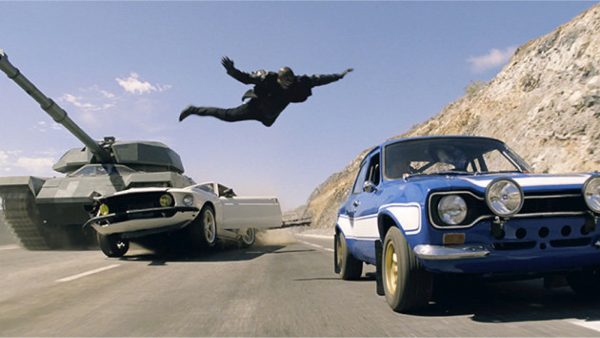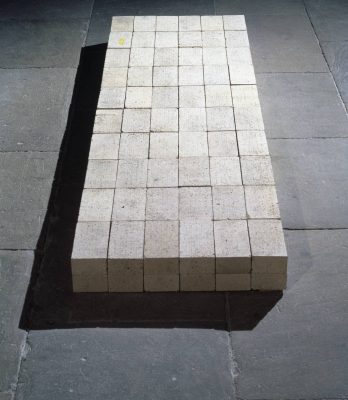The six chapters that comprise the Fast & Furious franchise thus far (a seventh is due for release in April 2015) are not complicated films. Their forcefulness is brutish, masculine, needlessly violent, and frequently uproarious. They are at times wildly sexist. They are targeted directly at – and appeal to – a generation of culturally confused middle-class, middle-America, middle-of-the-road young men.
They are the sort of movies you expect them to be, and despite the fact that you probably haven’t seen them, you are right to suppose the majority of what you do. You might have written them off as crass, rococo Hollywood offerings undeserving of the attention of discerning adults. You would be largely correct in assuming that the films contain outrageous stunts and implausible plotlines; dialogue and acting as flat and as unpalatable as the Dead Sea. Despite all this, they are the most profitable franchise in the history of Universal Studios; the most recent film, FF6[1], took $789m at the box office last year, and Dwayne ‘The Rock’ Johnson became 2013’s highest grossing Hollywood actor. While it was at first unclear whether the films were planned as a franchise – although it must have been devoutly wished – it is now unclear if or when they will ever stop. Despite the sad – and darkly ironic – demise of one of the movies’ main stars, Paul Walker (he died after he and a friend crashed a Porsche Carrera GT at high speed in a 45mph zone), Universal have signaled that they intend to continue filming with FF7, and have since brought in Walker’s brother to continue in his stead.
Working on the assumption that the majority of The White Review readers are not up to speed on the series’ elaborate plotline, I’m going to offer a brief rundown. FF1, which was released in 2001, saw Walker’s acting breakthrough as LAPD cop Brian O’Conner. Working undercover attempting to infiltrate an illegal street-racing scene in LA, he begins to frequent a diner that he knows to be a hub of just this sort of activity. While there, he meets and falls for Mia (played by Jordana Brewster) as she daily makes him his tuna salad sandwich, crusts removed. (O’Conner is a very no-crusts kind of guy.)
Walker, who had the fresh, callow good looks of a milk-fed Mormon in a Just For Men advert, seems uncannily out of place amongst the ghoulish muscle-bound thugs into whose world he must try to gain entry. One day at the diner, some trouble ensues and a lot of dog-pissing-on-lamppost sort of territory marking is rolled out with reference to Mia. Enter: Dominic (‘Dom’) Torretto, Mia’s brother (played with sumptuous ease by Vin Diesel), a man whose arms are so large and bulbous that they look like two condoms filled with wrestling whales. Eventually, Brian manages to enter one of these races (in an FBI-supplied Mitsubishi Eclipse GSX[2]), but Dom utterly dominates him in a cruel quarterback-on-chess-club-captain kind of a way, meaning that Brian now owes Dom a car. Once the race is over, the crowd is broken up by the cops. Dom stashes his ride in a parking garage, and tries to escape on foot, only to be rescued by Brian. This earns Brian some serious brownie points, and he’s in like Flynn with the gang. (Concurrent to all of this is a hijacking subplot involving – as will become de rigueur in the series – non-specific Asian gangsters.)
Various races and shootings then occur, and it transpires that Brian has it all wrong about the Asian gangsters and it is in fact Dom and his gang of not-so-merry men who are responsible for the hijackings. This leaves Brian in something of a quandary; to wit he is in love with Mia, but doesn’t want to send her brother and only family member to the prison he so patently deserves. Soon enough, he accidentally reveals his identity to Dom and the crew, and although they’re pissed as hell, they approach the situation as true American pragmatists and accept Brian’s help to flee. The film ends[3] with a real blazer of a chase during which they both narrowly avoid a startlingly fast freight train and Dom crashes out pretty badly. Brian gives Dom the keys to his ride (at this stage he’s cruising in a 1995 Toyota Supra Mk IV) thus allowing him to escape, and simultaneously making good on his vehicular debt. Dom is later seen, as all escaping (anti-) heroes should be, driving into a Mexican sunset, the ochre light bouncing off of his ovate head.
In 2003, with a budget double that of its predecessor, 2 Fast 2 Furious screeched its way into multiplexes everywhere. After the debacle at the end of the first chapter, Brian is on the run from the LAPD and hot-footing it across the country to Miami. There, he falls in with Tej Parker (played by the rapper Ludacris), a man so louche he makes Hugh Heffner look classy by comparison, and another motley crew of short-skirted girls, ripped dudes, and criminally-inclined petrol heads. Soon enough, Brian is racing again, and soon enough, Brian is again in trouble with the law, this time in the form of square-jawed US Customs Officer Markham. In return for wiping his criminal record, Markham wants Brian to go undercover – again – as a driver for an Argentinian drug lord (the films divide the roles of the bad guys pretty evenly between Asians and Latin Americans; Middle Eastern baddies are still to come, in FF7) called, rather implausibly, Carter Verone. Brian accepts, and manages to rope in his old pal Roman Pearce (Tyrese Gibson) who proceeds to oscillate between extreme je m’enfoutisme and Tom & Jerry-level hysteria until the end of the film.
Soon Brian and Roman are embroiled in a money-laundering operation, which, as you might expect, somehow unfurls by way of high-speed street races and under-prepared, outlandishly executed back-up plans resulting in astonishingly minimal injury. During all of which, Brian manages to ensnare the sultry attentions of FBI agent Monica Fuentes (Eva Mendes, barely recognizable under a geological age of makeup). Finally, Verone goes down and Roman and Brian make off with some of the loot, thereby introducing one of the key themes of the series: a crooked brand of Robin Hood justice eked out by a gamekeeper-turned-poacher whose threadbare ethical code extends only as far as his bank account. Justice, in this high-octane world, is measured out in terms of profit.
The next film – that which we will call FF3, but which is the only film with a markedly different title – The Fast and the Furious: Tokyo Drift – represents, at least to my mind, a dark hour in the history of the franchise. In fact, FF3 is such an abysmal cinematic episode – and indeed does so little to further the narrative (as I see it) of the films as a cohesive body of work – that I shall pass it over in order to take us more quickly to the franchise’s ‘mature’ period. Suffice it to say that FF3 lacks any of the original cast, save the brooding countenance – part Don Corleone, part Shrek – of Vin Diesel’s Dominic Toretto who appears briefly in a cameo at the film’s closing, with no real explanation except perhaps as a way of seeing how much he can make his flared nostrils resemble the exhaust pipes of the car he’s driving.
FF4 (2009[4]) reunites the entirety of the original ‘family’[5], and although it goes some way to introducing, with typical brio, a number of key themes from the films’ political agenda (the confusion of the idea of state borders with barriers to freedom as well as a porous and ill-defined idea of law enforcement in which criminals help the FBI and vice-versa), is it not until FF5 and FF6 that the cards are well and truly on the table, ideologically speaking. But have no fear: the cars keep rolling (and crashing), the girls keep bending over, and as is so often the case in America, the hammer is used in place of the scalpel, and the brute force of physical aggression does the work of the politically meticulous.
***
The Fast & Furious films are not made to be taken seriously. Viewed as a whole, however, they are guided by a powerful and iniquitous moral compass, a manifestation of deeper social and even psychological changes (or regression) that the American public has undergone in the past half-century: widespread suspicion of institutions, and a galling – and unjustified – confidence in the self over the state. The early American values of self-sufficiency and expansive, exploratory freedom are once again alive and well at the forefront of political debate in America – values traditionally shown as being embodied in the figure of the cowboy, but which may also be seen in that of the privateer. These men, who were instrumental in defeating Britain’s navy during the American War of Independence, were essentially state-sanctioned pirates employed to disrupt British military and commercial vessels. However, as Phillip Bobbitt has written in his masterpiece, Terror and Consent, ‘Even though they had periods of legitimate privateering, they eventually turned their violence against noncombatants and neutrals in the service of their own remarkable political societies which were notable for their ruthlessness, their egalitarianism, their racial and ethnic diversity, and their homosexuality [for FF purposes, here read ‘bromance’].’[6]
It is in this secondary role – more buccaneer than privateer, really – that we may start to understand Toretto and his ‘family’. (Helpful, too, will be the figure of the jester, but of that more later.) The role is one that has remained central to American political and social life, from the minutemen manning the US-Mexican border, to state militias and extreme survivalists, this kind of vigilante has always played a part in American life. Though throbbing V8s may have replaced their billowing sails, and their cutlasses been transposed with semi-automatics, these fast and furious folk are marauders in an old American tradition.
While of course Toretto was never state-sanctioned (although in FF6 this changes somewhat), O’Conner was that most steadfast of stately hands: an FBI agent. However, by the time we get to FF5 he is an almost gleefully adroit criminal, hiding out in favela safe-houses with his (pregnant) girl and accepting two-bit hijacking jobs for petty cash. It is during just such a heist – a rather remarkable heist, actually, involving the theft of several very high-end automobiles from a moving train – that our story picks up. Hidden inside one of these cars is a microchip with the locations of all the ‘cash houses’ belonging to the drug king of Rio de Janeiro, Herman Reyes. This crime attracts the attention of Diplomatic Security Service (DSS) special agent Luke Hobbs, a part that allows Dwayne ‘Can You Smell What “The Rock” Is Cooking?’ Johnson the opportunity to pair a pharaonic beard with the hieroglyphs etched on his weapons-grade biceps.
(The inclusion of Johnson in FF5 is crucial and, to my mind, a turning point in the series. As discussed above, the films had taken a stylistic nosedive with FF3 & FF4, but the appearance of a proper nemesis – albeit one on the ‘right’ side of the law – gives the franchise a new lease of life. It’s also a pleasant shock to discover that Johnson can act at all[7], but when this infamous American strongman is also blessed with some of the best – and most significant – lines, it’s hard not to be beguiled by his addition to the cast).
Called in to bring Toretto et al. to justice once and for all, Hobbs sets about deploying his crack team of minions to seek them out in the slums above Rio. In a sequence of dialogue lines, Hobbs eerily mimics the lingo one imagines overhearing at one of Obama’s notorious ‘kill-list’ meetings: ‘All these guys are is names on a list. They come up, we take ’em down, not a phone call more, not a bullet less.’ Soon after, with reference to tracking Reyes, Hobbs reflects a whole world of surveillance ability that has only recently come to horrifying light: ‘If he goes to the john, I want to know how many times he shakes it.’ His speeches, which are generally delivered with what he clearly believes to be Old Testament aplomb – and which certainly have a style all their own – often come with a ‘goddamn’ or two thrown in for folksy good measure.
Toretto and O’Conner decide to steal the all the money in all the cash houses (some $100m[8]) but must of course assemble a crew to help them do this. The situation is not helped by the fact that Reyes is so powerful, and the Brazilians apparently so corrupt that he is actually able to store his cash in a vault at police headquarters. This, along with the fact that the only thing we are shown of Rio (the majority of filming took place in Costa Rica) is either slum housing, bent cops or gun-encrusted villains, goes some way towards giving a picture of how the films think about the outside world. While this is by no means an outlook unique to these films, the fact that this strain of casual xenophobia has been consistently maintained over this number of films changes our reading of it from incidental ignorance to genuine prejudice.
So, along with many old friends, we encounter a few new comrades whose characters are lifted unabashedly from the Ocean’s Eleven playbook: Han, who like Brad Pitt’s character is always eating and making snide remarks from the sidelines; and Leo and Santos, brothers of indeterminate nationality whose bickering so perfectly mimics that of the redneck brothers in the Ocean’s films that it’s a wonder a plagiarism suit hasn’t been brought. Thankfully Roman Pearce is also on hand to lower the tone of the proceedings generally and, when he is told the size of the loot ($11m a-piece), tastefully remarks, ‘That’s a whole lotta vaginal activity.’
Their crafty den is soon discovered, however, and there ensues the tussle we’d all been waiting for (hell, I assume bets were placed by excited attendees of the film’s première): Vin Diesel v The Rock.[9] This is also a critical juncture at which to understand Johnson’s (and to a lesser extent Diesel’s) role in these films, to wit, that of jester. This ancient courtly figure (not strictly a courtier, the jester exists in a limbo unprotected from the direct whim of the sovereign) is inherently political and has the ability to speak truth to power precisely because the seriousness of his pronouncements exist in a state of flux. While of course the on-screen violence that’s meted out is highly falsified, it is the violence that Hobbs[10] represents – the unbridled American kind[11] – which becomes difficult to take seriously. The contrast between this ludic violence and the notion that similar things might actually be happening to real human bodies somewhere is stark, becoming almost ludicrous. Habituated to seeing Johnson partake in only the most thespian of violence in the wrestling ring, audiences’ de facto reaction can only be one of bread-and-circuses amusement, and the violence represented – that is being culturally sanctioned – is brushed off like so much dust after a grenade explosion.
For reasons that are unclear and will require a sharper eye than mine to ascertain, Hobbs eventually teams up with Toretto and the gang in order to take down Reyes together. Honour, it seems, may be thick amongst thieves, but it’s even thicker between guys who could bench-press a truck. The heist they must pull off is an extraordinarily ambitious feat, which will involve the actual removal of the safe from the police station (and its swapping for a fake whilst dragging it through the streets of Rio) and some amazing feats of vehicular wizardry, natch. Reyes bites the dust and, to show his gratitude for their help, Hobbs lets Toretto and O’Conner go, saying that he’ll give them twenty-four hours to get out of dodge. They escape with the real safe and all the cash, leaving Hobbs on a bridge holding nothing but his proverbial and confronted by an empty safe.
It is in FF6 that the opportunity arises for the Toretto / Hobbs double-act which really tops off the series. Hobbs is tracking yet another dastardly band of vehicular larcenists, this time led by Owen Shaw (Luke Evans) who has the officer-class malevolence of The Jungle Book’s Shere Khan. So adept are this new crew, and so dangerous are their goals thought to be that Hobbs enlists the help of Toretto and the family and we’re off to the races.
The opening scenes play fast and loose with locations so that Lambeth Bridge (with MI5 in the background) stands in for a bridge on the Moscova, and London’s Interpol headquarters is in UCL’s Senate House[12]. Therein, Hobbs gets medieval on some poor unfortunate cockney who he believes will spill information leading to Shaw. Witnessing the smack down from behind some soundproof glass an Interpol flunkey says to Hobbs’ second in command: ‘Is that legal?’ ‘No’, she replies, ‘but are you gonna go in there and tell him?’ This flippant attitude epitomizes these films’ attitude towards torture; just in the same way that saying ‘enhanced interrogation’ instead of ‘torture’ is at both meaningless and demeaning, treating it with frivolity – retreating into euphemism – shrugs off responsibility. Watching Hobbs throw a man around a room, beating him with folded chairs and throwing him like a rag doll at the ceiling, it is impossible to see the character of Hobbs through the presence of The Rock and the violence then becomes almost comic, creating an even greater remove between that which is happening in CIA prisons in Polish forests and that which we are actually watching. Sometimes comedy lightens the load of grave matters so much that they just float away.
Toretto and the guys successfully track down Shaw, just managing to stop him from building his ‘nightshade’ bomb (a device that would wipe out electronics and communications within a vast radius for up to twenty-four hours; nowadays, it seems that the fear of the mushroom cloud has been surpassed by the sheer terror of being unable to charge one’s Apple devices) and the film culminates with a truly electrifying – though wholly derivative – car-alongside-plane chase along a seemingly endless runway. Shaw perishes, being thrown to the ground just before the plane fireballs, and Toretto secures a crucial computer chip, exchanging it with Hobbs for his and the family’s amnesty. They return to America, where hot dogs are thrown on the grill and beer bottles are clinked with a sense of distilled and earned liberty à la Shawshank Redemption.
***
The Fast & Furious films are not particularly complicated, and nor are they intended to be. However, the feeling that films seen by great swathes in megaplexes both in America and across the world (the films are hugely popular in Asia) warrant no more investigation than tweets and ignominious reviews on ratings websites is wrong. These films are important viewing precisely because so many people see them. This is the America that is ignored, patronised, and lambasted in the international liberal media. Even as the movies extol a viciously triumphalist, radical agenda which is so in-step with Middle America, so they are treated as mere froth. And so they appear to be, and so they go calmly and exhaustively on. (In case it didn’t sink in earlier, they are now making the seventh in the series.)
These films are far from unusual in Hollywood for their espousal of hawkish views, their displays of casual yet meaningful violence. It’s just that these movies are, I believe, unique both in the size of the series and in their box-office takings. Couple those two facts with astonishingly low party-political engagement, and you find a nation of young men and women receiving a political education from the multiplex. Like it or not, the roving, boundless figure of Hobbs represents for many a heroic, business-like way of American foreign intervention, and making light of this role serves only to perpetuate it. It’s not the fault of the films that this remove exists; it is, rather, symptomatic of a wider cultural malaise that has caused entertainment to become paramount over information and opinion over fact. These films are, in their way, a different kind of political engagement, one that we are in danger of overlooking entirely.
***
[1] In the interests of simplicity, I will be referring to the films sequentially, by number (FF1–FF6), rather than by their bland (and oftentimes indistinguishable) titles.
[2] Modified Mitsubishi Eclipse GSX; all cars referred to, unless otherwise stated, are heavily modified and there is a running theme in all of the movies which pits foreign (‘imports’) against the homegrown (‘straight-six’) purity of American muscle. This East v. West conflict hardly needs elaborating here, but the fact that O’Conner is a dedicated import driver until, concurrent to his conversion to the role of marauding villain, he converts to the cause of American muscle, is for obvious reasons significant.
[3] At this point I should definitely mention that this article contains innumerable spoilers.
[4] N.B. The year after the election to presidential office of Barack Obama, and the year in which the Tea Party movement came to national prominence.
[5] Toretto refers to his merry band of kleptomaniac petrol-heads as his family, in much the same way that Charles Manson used that nomenclature to group together his murdersome New Age gaggle.
[6] Bobbitt, Philip. Terror and Consent: The Wars for the Twenty-First Century, pp 30-31. New York: A.A. Knopf, 2008.
[7] Having said which, anyone familiar with The Rock’s performances in WWF and subsequently WWE from the mid-1990s until the present day, will remember him as a consummate and accomplished performer, with a surprisingly dulcet voice. Those who don’t should spend a diverting quarter-hour here:
https://www.youtube.com/watch?v=J4ueFDnWT5Y
[8] O’Conner is able to estimate this from the weight of each parcel moved; apparently 49 kilos of twenties is roughly a million bucks and dealers in the big time don’t even have the time or inclination to count their money, which, regardless of whether or not it is true, is a pretty sensational notion.
[9] At this point the characters dissolve and the largesse of both men is fully on display as they take the measure of each other.
[10] Hobbs could perhaps be seen to be the steroid-emboldened embodiment of his homonymic namesake’s theory of ‘sovereignty by acquisition’ (i.e. being conquered and agreeing to obey the conqueror), the establishment of which, in Thomas Hobbes’ eyes, carries equal political legitimacy as ‘sovereignty by institution’ (agreeing mutually whom to obey). The wonderful Americanism, ‘I’m gonna own [his/her/your] ass’, so often heard in the wrestling ring, might perhaps attain new meaning in this Hobbs(e)ian light.
[11] The DSS motto is ‘Protecting Americans Around the World’.
[12] In a delicious piece of coincidence, Senate House was also the model for the Ministry of Information in George Orwell’s Nineteen Eighty-Four.




